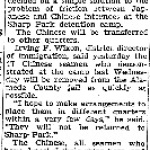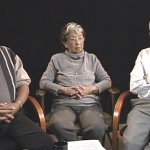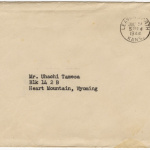Sites of incarceration
During World War II, over 120,000 persons of Japanese descent were held in a variety of incarceration sites spread across the United States. These sites were run by several different U.S. governmental agencies and served multiple purposes. The following is a brief summary of the different facility types:
Concentration Camp
One of ten specially constructed, longer term camps operated by the War Relocation Authority to hold Japanese Americans forcibly removed from the West Coast, a total of 120,000 people including those born in the camps or transferred to them later. These camps, which were built in desolate areas far from population centers, began operating in the summer of 1942 with most inmates transferred to them from the short term holding centers euphemistically called "assembly centers." While some inmates were able to leave these camps for resettlement inland by the end of 1942, most remained in the camps until 1945, with the last concentration camp, Tule Lake , not shutting down until March of 1946.
Temporary Assembly Center
One of sixteen short term camps—mostly adapted from existing facilities such as fairgrounds and horse racing tracks—hurriedly prepared and opened by the Wartime Civil Control Administration in the spring of 1942 to house Japanese Americans upon their initial forced removal from the West Coast. These camps were generally located fairly close to the communities in which the excluded Japanese Americans had lived. Through the late summer and fall of 1942, inmates were transferred from these camps to the more permanent concentration camps operated by the War Relocation Authority. The last of the temporary assembly centers closed in October of 1942. (See also, Assembly Centers )
Immigration Detention Station
The initial holding facilities for most of 5,500 Japanese nationals arrested by the FBI in the immediate aftermath of the attack on Pearl Harbor. Most of those arrested were male Issei , held without formal charges, many of whom were immigrant generation community leaders. These temporary facilities operated by the Immigration and Naturalization Service (INS) held internees from a few weeks to many months until they could be transferred to larger Department of Justice (DOJ) internment camps. The INS typically used local immigration stations such as the ones in Honolulu, Seattle, and San Francisco; however, county jails, hotels, and former campsites also served as initial sites.
Department of Justice Internment Camp
Longer term camps for Japanese nationals—as well as some German and Italian nationals and Japanese Latin Americans—who were arrested by the FBI all over the United States following the attack on Pearl Harbor. These individuals were transferred to the Department of Justice internment camps after generally short stays in the immigration detention stations. While at the internment camps, they received hearings that determined whether the Issei would remain in the internment camps or be "released" to the War Relocation Authority (WRA) concentration camps. After the hearings, most of the Issei were sent to U.S. Army internment camps where they remained through May 1943, when they were transferred back to the Department of Justice given the increasing number of prisoners of war the army needed to house. Most of the DOJ internment camps held only men who had been separated from their families, but three camps— Seagoville , Crystal City , and Old Raton Ranch —housed single women and the family members of the interned Issei, many of whom had "voluntarily" opted to join their husbands/fathers.
U.S. Army Internment Camp
Internment camps that held enemy aliens arrested after the attack on Pearl Harbor in 1942–43. Mostly built on existing military bases, most Issei held by the Justice Department were transferred to these camps after their hearings. In May of 1943, the army began transferring these internees back to the Justice Department, because of the growing number of prisoners of war (POWs) it needed to house. Only one of these camps— Camp Lordsburg in New Mexico—was specifically built to house people of Japanese descent.
Citizen Isolation Center
Prisons built by the War Relocation Authority to house Nisei and Kibei "troublemakers" after the unrest at Poston and Manzanar at the end of 1942. While Issei dissidents could be transferred to the Justice Department, Nisei and Kibei as U.S. citizens could not, necessitating the opening of these WRA jails.
Additional Facility
Other specialty facilities built by the War Relocation Authority that included a recreation camp for inmates at Topaz and two facilities built to isolate specific groups of inmates from Manzanar and Tule Lake.
U.S. Federal Prison
Operated by the Federal Bureau of Prisons, these facilities held groups of Japanese American draft resisters.
Last updated Jan. 16, 2024, 12:39 a.m..








